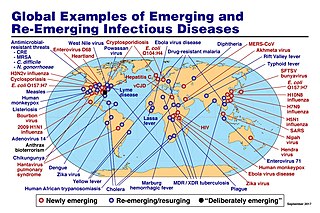Related Research Articles

Bioterrorism is terrorism involving the intentional release or dissemination of biological agents. These agents include bacteria, viruses, insects, fungi, and/or their toxins, and may be in a naturally occurring or a human-modified form, in much the same way as in biological warfare. Further, modern agribusiness is vulnerable to anti-agricultural attacks by terrorists, and such attacks can seriously damage economy as well as consumer confidence. The latter destructive activity is called agrobioterrorism and is a subtype of agro-terrorism.
Biodefense refers to measures to counter biological threats, reduce biological risks, and prepare for, respond to, and recover from bioincidents, whether naturally occurring, accidental, or deliberate in origin and whether impacting human, animal, plant, or environmental health. Biodefense measures often aim to improve biosecurity or biosafety. Biodefense is frequently discussed in the context of biological warfare or bioterrorism, and is generally considered a military or emergency response term.
The National Institute of Allergy and Infectious Diseases is one of the 27 institutes and centers that make up the National Institutes of Health (NIH), an agency of the United States Department of Health and Human Services (HHS). NIAID's mission is to conduct basic and applied research to better understand, treat, and prevent infectious, immunologic, and allergic diseases.

The Biocomplexity Institute of Virginia Tech was a research institute specializing in bioinformatics, computational biology, and systems biology. The institute had more than 250 personnel, including over 50 tenured and research faculty. Research at the institute involved collaboration in diverse disciplines such as mathematics, computer science, biology, plant pathology, biochemistry, systems biology, statistics, economics, synthetic biology and medicine. The institute developed -omic and bioinformatic tools and databases that can be applied to the study of human, animal and plant diseases as well as the discovery of new vaccine, drug and diagnostic targets.

The Influenza Genome Sequencing Project (IGSP), initiated in early 2004, seeks to investigate influenza evolution by providing a public data set of complete influenza genome sequences from collections of isolates representing diverse species distributions.

An emerging infectious disease (EID) is an infectious disease whose incidence has increased recently, and could increase in the near future. The minority that are capable of developing efficient transmission between humans can become major public and global concerns as potential causes of epidemics or pandemics. Their many impacts can be economic and societal, as well as clinical. EIDs have been increasing steadily since at least 1940.
Jorge Benach is a medical researcher at the Stony Brook University in New York state. Benach is the chair of the Department of Molecular Genetics and Microbiology. Benach's main area of research is the tick-borne spirochete Borrelia burgdorferi, which is the causative agent of Lyme disease.
The Immune Epitope Database and Analysis Resource (IEDB) is a project hosted by scientists at the La Jolla Institute for Allergy and Immunology (LIAI), with support from the National Institute of Allergy and Infectious Diseases (NIAID), a part of the National Institutes of Health (NIH), and Department of Health and Human Services (HHS). The focus is dissemination of immune epitope information to facilitate the generation of new research tools, diagnostic techniques, vaccines and therapeutics.
The Viral Bioinformatics Resource Center (VBRC) is an online resource providing access to a database of curated viral genomes and a variety of tools for bioinformatic genome analysis. This resource was one of eight BRCs funded by NIAID with the goal of promoting research against emerging and re-emerging pathogens, particularly those seen as potential bioterrorism threats. The VBRC is now supported by Dr. Chris Upton at the University of Victoria.
The National Microbial Pathogen Data Resource was one of the eight Bioinformatics Resource Centers funded by the National Institutes of Allergy and Infectious Diseases, NIAID a component of the National Institutes of Health (NIH), which is an agency of the United States Department of Health and Human Services. The NMPDR was funded for five years from 2004 through a grant to co-PI's Rick Stevens from the Computation Institute at the University of Chicago, and Ross Overbeek at the Fellowship for the Interpretation of Genomes.

The Vaccine Research Center (VRC), is an intramural division of the National Institute of Allergy and Infectious Diseases (NIAID), part of the National Institutes of Health (NIH), US Department of Health and Human Services (HHS). The mission of the VRC is to discover and develop both vaccines and antibody-based products that target infectious diseases.
VectorBase is one of the five Bioinformatics Resource Centers (BRC) funded by the National Institute of Allergy and Infectious Diseases (NIAID), a component of the National Institutes of Health (NIH), which is an agency of the United States Department of Health and Human Services. VectorBase is focused on invertebrate vectors of human pathogens working with the sequencing centers and the research community to curate vector genomes.
Pathema was one of the eight bioinformatics resource centers funded by the National Institute of Allergy and Infectious Diseases (NIAID), a component of the National Institute of Health (NIH), which is an agency of the United States Department of Health and Human Services.
PATRIC was a bacterial bioinformatics website from the Bioinformatics Resource Center, originally created in 2004. It has since been combined with the Influenza Research Database and the Virus Pathogen Database and Analysis Resource Center to create the Bacterial and Viral Bioinformatics Resource Center (BV-BRC). It is an information system that integrates databases and analysis tools. It focuses on various data related to bacterial pathogens. PATRIC facilitates integration of various types of pathogen information to support biomedical research on bacterial infectious diseases.
Ravn virus is a close relative of Marburg virus (MARV). RAVV causes Marburg virus disease in humans and nonhuman primates, a form of viral hemorrhagic fever. RAVV is a Select agent, World Health Organization Risk Group 4 Pathogen, National Institutes of Health/National Institute of Allergy and Infectious Diseases Category A Priority Pathogen, Centers for Disease Control and Prevention Category A Bioterrorism Agent, and listed as a Biological Agent for Export Control by the Australia Group.
The Virus Pathogen Database and Analysis Resource (ViPR) is an integrative and comprehensive publicly available database and analysis resource to search, analyze, visualize, save and share data for viral pathogens in the U.S. National Institute of Allergy and Infectious Diseases (NIAID) Category A-C Priority Pathogen lists for biodefense research, and other viral pathogens causing emerging/reemerging infectious diseases. ViPR is one of the five Bioinformatics Resource Centers (BRC) funded by NIAID, a component of the National Institutes of Health (NIH), which is an agency of the United States Department of Health and Human Services.
The Influenza Research Database (IRD) is an integrative and comprehensive publicly available database and analysis resource to search, analyze, visualize, save and share data for influenza virus research. IRD is one of the five Bioinformatics Resource Centers (BRC) funded by the National Institute of Allergy and Infectious Diseases (NIAID), a component of the National Institutes of Health (NIH), which is an agency of the United States Department of Health and Human Services.

The Eukaryotic Pathgen Database, or EuPathDB, is a database of bioinformatic and experimental data related to a variety of eukaryotic pathogens. It was established in 2006 under a National Institutes of Health program to create Bioinformatics Resource Centers to facilitate research on pathogens that may pose biodefense threats. EuPathDB stores data related to its organisms of interest and provides tools for searching through and analyzing the data. It currently consists of 14 component databases, each dedicated to a certain research topic. EuPathDB includes:
Karl M Johnson was an American virologist, known for discovering Machupo virus, Hantaan virus, and Ebola virus. He has held key positions in the American Society of Tropical Medicine and Hygiene.

Emily J. Erbelding is an American physician-scientist. She is the director of the Division of Microbiology and Infectious Diseases at the National Institute of Allergy and Infectious Diseases (NIAID). Erbelding was previously deputy director of the Division of AIDS at NIAID. She was a faculty member at Johns Hopkins School of Medicine and served as director of clinical services for the Baltimore City Health Department STD/HIV program.
References
- ↑ Overview, Bioinformatics Resource Centers Archived May 15, 2008, at the Wayback Machine , National Institute of Allergy and Infectious Diseases (NIAID), January 10, 2008.
- ↑ CDC Bioterrorism Agents and Diseases (By Category) Archived 2014-07-22 at the Wayback Machine , Centers for Disease Control and Prevention (Department of Health and Human Services), accessed July 8, 2008.